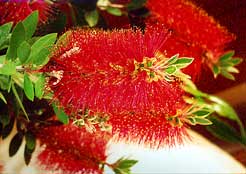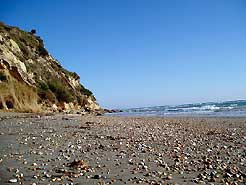History
Being strategically located and having a sheltered and easily defended deep-water port, (Argostoli) plus plentiful supplies of food and water, the island has an interesting history. Pirate raids were common for several centuries. Since Roman times the island has been controlled by Turks, Russians, Venetians, the French and lastly the British who left in 1864 when the Ionian Islands were finally re-united with Greece . Anyone who has read �Captain Corelli's Mandolin�, or seen the film, will be aware of it's grim WW2 experiences. This was followed by the major earthquake of 1953 when 100,000 inhabitants left the island. (Houses today are constructed to withstand earthquakes far greater than that of 1953.) Tourism here started much later than in many other Greek islands which is why Kefalonia remains relatively unspoilt.

Is Paliki really Ithaka?
Over the years, several scholars have put forward the theory that Paliki is in fact the original home of Homer's Odysseus, and not the nearby island of Ithaka, which was only so named sometime in the 17th century, long after The Odyssey was written. There is a major ongoing scientific project which aims to prove that Paliki was once a separate island not connected to the rest of Kefalonia. If this is established, the case for Paliki being Homer's� Ithaki� will be considerably strengthened. For more information about this project, visit www.odysseus-unbound.org

Archaeology
The island is rich in prehistoric remains and there is evidence of human habitation dating back to 4000 BC and perhaps considerably earlier. There have been many interesting archaeological finds some of which can be seen in the Museum in Argostoli. Near present day Sami one can walk around the remains of the much older original Samos sacked by the Romans, and just about anywhere on the island, ancient stonework can be seen. Skala boasts a well preserved Roman mosaic floor.

Flora and Fauna
Kefalonia is a delightfully green island, even in the heat of summer. Spring is probably the best time to enjoy the islands flora at its most colourful, however an amazing range of flowers and herbs can be seen, and indeed smelt, at almost any time of year. As for trees, Cypress, Pine, and Holm Oak abound, and of course Olive trees both wild and cultivated. Despite the fact that many Greeks still regard birds as something to be shot at, there is a surprisingly rich array of birds on the island especially during migration. These include hawks, kestrel, buzzards, house martens various finches, and woodpeckers. Eagles have been spotted on occasions. If you are lucky you may catch a glimpse of some of the wild horses that roam Mt Ainos. Other rarities include monk seals and loggerhead turtles.

Agriculture
Despite the growth of tourism in the late 60's, Kefalonia remains predominately agricultural. There are many vineyards - the island's crisp white Robola wine is widely exported - plus olive groves, citrus trees, beehives, pigs, sheep and goats. These last can be found wandering the hillsides and indeed often on the road! Much of what is served in the restaurants and tavernas has been produced on the island.
The people
Kefalonians are known not only for a certain eccentricity, but also for their hospitality and the warm welcome given to visitors and new residents alike. Speak to anyone who has moved here from UK and they will likely have tales of friendly locals bringing welcome gifts of fruit, or home-made wine. The island has also produced more than its fair share of artists, writers and musicians and the strong musical tradition is evident throughout the island on the many festivals and public holidays. There is a School of Music in Lixouri. A strong sea-faring tradition means that many locals you encounter have travelled widely and are therefore interesting characters with many tales to tell.
Lixouri
Lixouri and the surrounding area of the Paliki Peninsula covers an area of 145 km sq. Lixouri, together with the 22 villages that are situated within the Peninsula have a population of about 6,500 people that live here all year round. This number increases in the summer as many Greek people have family homes here, but work and live in Athens, Canada, America, Australia and England for the rest of the time. There is also a 50 strong population of �non-greeks' that live here, this number is increasing steadily each year.
What attracts people to Lixouri?
This question has been asked many times and to many different people that live and visit here. The reply is very consistent.
Firstly they say it is the friendliness, warmth and kindness of the people.
Secondly they feel that Lixouri has a village type atmosphere, despite being the second largest town on the island.
Thirdly the geography and the layout of the town. The majority of Tavernas and Restaurants are situated on the seafront next to the harbour. The shops and facilities are all ideally situated round the square and on adjacent roads leading off the square.
Finally it is a working town all year round. The land around Lixouri stretching out to the villages is agricultural land, with small holdings on which many locals grow their own produce, which they then harvest and sell in town. The local market is daily and positioned at the foot of the bridge.
Among the facilities that Lixouri have to offer are:-
- Hospital
- Chemists
- Banks
- Supermarkets
- Schools
- Nurseries (both state run and private)
- 2 Primary Schools
- 1 Secondary School
- Music School
- Private Language School
- Music Collage (attended by students from all over Greece)
- Gymnasium (new) run by the local council
- Fitness Clubs
- Sailing School & Club
- Horse Riding & Pony Club
